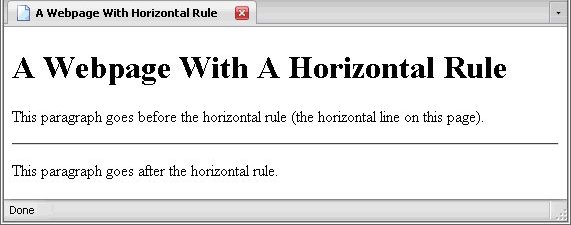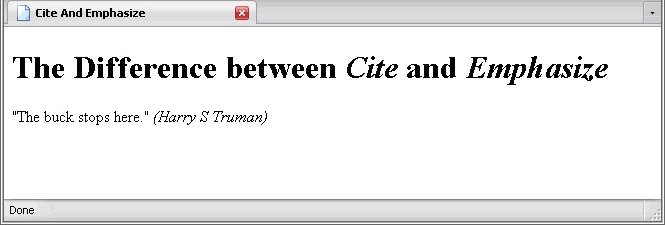Empty Elements
Empty elements consist solely of an opening tag; they have neither content nor closing tag. Two examples are the horizontal rule element and the image element.
The Horizontal Rule Element
The task of the horizontal rule element, which has the element name hr, is simple: place a horizontal line on the webpage. Below is an example:
Here is the result:
The Image Element
The task of the image element, which has the element name img, is a bit more complex: place a specific graphic on the webpage. Below is an example:
Here is the result:
Why Empty Elements Are Empty
As you know, the html, head, title, body, h1, p, em, strong, and a elements follow the start tag, content, end tag
format; in Your First Webpage, I demonstrated the effects of leaving out the end tag of a non-empty element. However, these elements differ from the hr and img elements in one fundamental aspect: non-empty can contain text and/or other elements. In other words, non-empty elements can have content.
Empty elements can't.
The information that the browser needs from an hr element is contained in the element name itself; in other words, the hr element tells a browser put a horizontal line here
by its very presence. When the start tag is finished, the browser is finished with the hr element.
The same goes for the img element. It tells the browser put an image here
by its very presence; which image to use is indicated by the src attribute (which stands for source
) and contains the URI of the image to use, and the text to display if the image doesn't appear is contained in the alt attribute. Again, once the start tag is finished, the browser is done with the element.
You could, of course, give hr and img elements extra information by adding title, class, id, and/or style attributes, but we already know that attributes are always contained in the start tag.
Therefore, the definition of an empty element is an element in which all possible information pertaining to that element is contained solely in its start tag. This is why there is no such thing as an /hr or /img tag in (X)HTML; they're needless and a browser will not recognize them.
If you have looked at the code for the page where I highlight parts of the code of the webpage demonstrated in Your First Webpage, you may have seen the following:
Considering there is nothing between the start tag and end tag of the script element, one might think that this should be an empty element. But recall I said all possible information. The src attribute refers to a separate file that is used as part of this page. I could easily place the contents of said file within the script element, and it would work equally well. Therefore, not all possible information is contained within the script start tag, therefore script is not an empty element.
There are 10 empty elements in HTML 4.01 Strict and XHTML 1.0 Strict, and I'll explain each one when we get to it.
XML And Empty Elements
Perhaps the most well-known difference between HTML and XHTML is the handling of empty elements. In HTML, an empty element is assumed to be closed when its tag ends. That's never the case in any XML language; the tag must be explicitly closed. The way to do this is to put a forward slash (/
) just before the greater-than character (>
); this is the extra use
of the forward slash I mentioned back in The Basics of Markup. Very often, a space is placed before the slash, which allows that slash to be read as a simple and minor syntax error when the page is read as HTML (which is, remember, the only way Internet Explorer and very old browsers can read XHTML). The space is not required when the page is read as an XHTML document, but it doesn't hurt.
The example below shows the hr and img elements as they would appear in XHTML.
Of course, this does mean that any element can technically be empty—but this can cause problems if the page is being read as HTML.


